Podcast: Play in new window | Download
Subscribe: Apple Podcasts | RSS
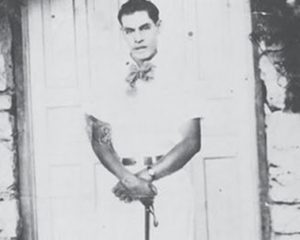 The date was February 8, 1928. The official presidential train carrying Plutarco Elías Calles, the first popularly elected president of Mexico, slowed down before making its final stop in the dusty desert town of Espinazo, Nuevo Leon. As the train slowed, the Mexican president was taken aback by the massive shantytown that had sprung up on the outskirts of a town of normally a hundred or so people. The shantytown had already gotten a nickname: El Campo del Dolor, or in English, “The Camp of Pain.” People living in these makeshift shelters, some constructed out of twigs gathered from the nearby desert, had come to this inhospitable place for the same reason as the regal-looking President Calles: they were hoping for a miracle, a cure, maybe just some hope, from a notorious local faith healer named El Niño Fidencio. Few people knew that the Mexican president was suffering from a mysterious skin condition, later described as a form of nodular leprosy, and while no doctors in Mexico City could seem to help Calles, the president decided to make an official visit to this small northern town to seek a miracle cure from this young man who had started to become so famous throughout Mexico and the rest of the world. The Niño Fidencio received the most powerful man in the country as he would have received any humble villager who had made the journey in hopes of a cure. After several faith healing sessions with Fidencio, including a 6-hour honey bath, President Calles’ skin condition disappeared and he returned in robust health to his life back in the nation’s capital. The Niño Fidencio’s fate as a miracle worker was now sealed.
The date was February 8, 1928. The official presidential train carrying Plutarco Elías Calles, the first popularly elected president of Mexico, slowed down before making its final stop in the dusty desert town of Espinazo, Nuevo Leon. As the train slowed, the Mexican president was taken aback by the massive shantytown that had sprung up on the outskirts of a town of normally a hundred or so people. The shantytown had already gotten a nickname: El Campo del Dolor, or in English, “The Camp of Pain.” People living in these makeshift shelters, some constructed out of twigs gathered from the nearby desert, had come to this inhospitable place for the same reason as the regal-looking President Calles: they were hoping for a miracle, a cure, maybe just some hope, from a notorious local faith healer named El Niño Fidencio. Few people knew that the Mexican president was suffering from a mysterious skin condition, later described as a form of nodular leprosy, and while no doctors in Mexico City could seem to help Calles, the president decided to make an official visit to this small northern town to seek a miracle cure from this young man who had started to become so famous throughout Mexico and the rest of the world. The Niño Fidencio received the most powerful man in the country as he would have received any humble villager who had made the journey in hopes of a cure. After several faith healing sessions with Fidencio, including a 6-hour honey bath, President Calles’ skin condition disappeared and he returned in robust health to his life back in the nation’s capital. The Niño Fidencio’s fate as a miracle worker was now sealed.
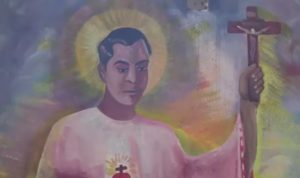 Born on November 13, 1898 in Valle de las Cuevas near the town of Iramuco, Guanajuato, José de Jesús Fidencio Constantino Síntora would later grow up to be the most famous curandero, or folk healer, in the history of Mexico. At the age of 8 young Fidencio had already begun to show his knack for healing. When his mother broke her arm, the young boy set the broken bone with sticks and the healing root of a night-blooming cactus. When asked how he knew what to do, Fidencio had no idea where he had learned that technique. Fidencio was semi-literate as he left school at the age of 10 to work. In 1909, at the age of 11, he and his older brother Joaquín left for the Yucatán to work on a maguey plantation. He was away from home for about 2 years. When he returned to Iramuco, he promptly left the town for the city of Morelia with the family of his friend, Enrique López de la Fuente. Fidencio, now 13, found work in the home of a wealthy family as a kitchen boy. Enrique, who was 2 years older than Fidencio, soon left Morelia to fight in the Mexican Revolution up
Born on November 13, 1898 in Valle de las Cuevas near the town of Iramuco, Guanajuato, José de Jesús Fidencio Constantino Síntora would later grow up to be the most famous curandero, or folk healer, in the history of Mexico. At the age of 8 young Fidencio had already begun to show his knack for healing. When his mother broke her arm, the young boy set the broken bone with sticks and the healing root of a night-blooming cactus. When asked how he knew what to do, Fidencio had no idea where he had learned that technique. Fidencio was semi-literate as he left school at the age of 10 to work. In 1909, at the age of 11, he and his older brother Joaquín left for the Yucatán to work on a maguey plantation. He was away from home for about 2 years. When he returned to Iramuco, he promptly left the town for the city of Morelia with the family of his friend, Enrique López de la Fuente. Fidencio, now 13, found work in the home of a wealthy family as a kitchen boy. Enrique, who was 2 years older than Fidencio, soon left Morelia to fight in the Mexican Revolution up  north. Fidencio would also leave to head up north, but not as a fighter. By 1915 it is reported that he was living near his sister Antonia who was working on a hacienda in Nuevo Leon. Also by 1915, after his duties in the revolution ended, Fidencio’s friend Enrique got a job on a sprawling ranch just outside of the town of Espinazo owned by a wealthy German named Teodoro von Wernich. When Fidencio heard of his friend’s arrival in the same area, he asked for work at the same ranch and was immediately put to use in the kitchen and doing household chores. By that time, at the very end of his adolescence, is when Fidencio got the nickname “El Niño” because his voice had not grown deeper, he was not able to grow a beard and he had a soft-looking face. The name, El Niño Fidencio, would stay with him until his death and beyond.
north. Fidencio would also leave to head up north, but not as a fighter. By 1915 it is reported that he was living near his sister Antonia who was working on a hacienda in Nuevo Leon. Also by 1915, after his duties in the revolution ended, Fidencio’s friend Enrique got a job on a sprawling ranch just outside of the town of Espinazo owned by a wealthy German named Teodoro von Wernich. When Fidencio heard of his friend’s arrival in the same area, he asked for work at the same ranch and was immediately put to use in the kitchen and doing household chores. By that time, at the very end of his adolescence, is when Fidencio got the nickname “El Niño” because his voice had not grown deeper, he was not able to grow a beard and he had a soft-looking face. The name, El Niño Fidencio, would stay with him until his death and beyond.
It was there at the von Wernich ranch where Fidencio honed his healing abilities. In his spare time he would wander the desert and commune with nature, observing animals and their interactions with the plants. He also sat with and learned from a local indigenous woman, a curandera, who taught him more about native plant remedies. Fidencio was a quick study and soon became known locally as a healer, practicing his type of folk medicine in his off hours. The owner of the ranch, Teodoro von Wernich, eventually made Fidencio the unofficial medical doctor of his various properties tending to both humans and animals. As Fidencio’s regional notoriety grew, his childhood friend, Enrique, tried to control him, seeing  Fidencio as a possible money-making machine. Fidencio was never into the money aspect of what he was doing, however, and saw his life on earth as a one of service to God through healing the sick. In his 20s Fidencio claimed to have had several supernatural visions and visitations, sometimes slipping into trancelike states to connect with an unseen spirit world. In one vision he was visited by a bearded man who showed him previously unknown secrets of desert plants that went beyond what the indigenous curandera had taught him. It was during this vision, sometime in 1927 that Fidencio believed he was given his mission on earth to heal and perform miracles, using a combination of plant-based remedies and his own techniques involving energies and a special connection to the Holy Spirit. To compound this, locals also believed that Fidencio was the fulfillment of a prophecy of a desert hermit who lived in the mid-1800s, a folk healer named Tatita Santo. Santo claimed that a great redeemer would arrive in Espinazo and would appear underneath the large pepper tree that grew in the center of town. The event that really propelled the Niño Fidencio’s healing career happened in late 1927. His employer, Teodoro von Wernich, was suffering from a sore on his leg that would not heal. He had been to many doctors but no one could cure him. Fidencio made a paste out of desert plants, applied the paste to the affected area, bandaged the leg and von Wernich’s wound miraculously healed. Von Wernich was so impressed that he placed an ad in a major newspaper in Mexico City celebrating the healing powers of his young employee. It was after this ad ran in the capital city’s newspaper when the floodgates opened
Fidencio as a possible money-making machine. Fidencio was never into the money aspect of what he was doing, however, and saw his life on earth as a one of service to God through healing the sick. In his 20s Fidencio claimed to have had several supernatural visions and visitations, sometimes slipping into trancelike states to connect with an unseen spirit world. In one vision he was visited by a bearded man who showed him previously unknown secrets of desert plants that went beyond what the indigenous curandera had taught him. It was during this vision, sometime in 1927 that Fidencio believed he was given his mission on earth to heal and perform miracles, using a combination of plant-based remedies and his own techniques involving energies and a special connection to the Holy Spirit. To compound this, locals also believed that Fidencio was the fulfillment of a prophecy of a desert hermit who lived in the mid-1800s, a folk healer named Tatita Santo. Santo claimed that a great redeemer would arrive in Espinazo and would appear underneath the large pepper tree that grew in the center of town. The event that really propelled the Niño Fidencio’s healing career happened in late 1927. His employer, Teodoro von Wernich, was suffering from a sore on his leg that would not heal. He had been to many doctors but no one could cure him. Fidencio made a paste out of desert plants, applied the paste to the affected area, bandaged the leg and von Wernich’s wound miraculously healed. Von Wernich was so impressed that he placed an ad in a major newspaper in Mexico City celebrating the healing powers of his young employee. It was after this ad ran in the capital city’s newspaper when the floodgates opened 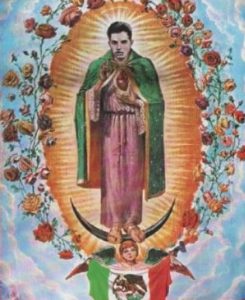 and people began arriving at Espinazo by the thousands. The shantytown around Espinazo grew as multitudes of people – suffering from all kinds of afflictions from tuberculosis to insanity – waited weeks or even months to be seen by the Niño Fidencio. The town soon got a post office and a telegraph station to accommodate the increase in population. Trains arrived with more frequency. During 1928 and 1929 reporters representing newspapers throughout Mexico came to Espinazo to write stories about this miracle worker. Through all of this, Fidencio maintained his humble demeanor, never demanding money or special treatment, and could be seen walking about the dusty streets of the town barefoot, dressed as a simple pilgrim. To many, Fidencio was a living, breathing saint.
and people began arriving at Espinazo by the thousands. The shantytown around Espinazo grew as multitudes of people – suffering from all kinds of afflictions from tuberculosis to insanity – waited weeks or even months to be seen by the Niño Fidencio. The town soon got a post office and a telegraph station to accommodate the increase in population. Trains arrived with more frequency. During 1928 and 1929 reporters representing newspapers throughout Mexico came to Espinazo to write stories about this miracle worker. Through all of this, Fidencio maintained his humble demeanor, never demanding money or special treatment, and could be seen walking about the dusty streets of the town barefoot, dressed as a simple pilgrim. To many, Fidencio was a living, breathing saint.
Not all of the attention Fidencio received was positive. As he was not an officially ordained member of the clergy, the Catholic Church had a problem with Fidencio’s healing ministry. The fact that tens of thousands of sick people were congregated in the shantytown on the outskirts of town drew concern from governmental health authorities. The possibility of contagion was very high. Indeed, many people did die in the Campo del Dolor as the wait was long for a cure or because they were already in the terminal stages of their ailments when they arrived at Espinazo. Several times Fidencio was called before the health authorities and each time he was allowed to continue with what he was doing with no changes made. A charge of practicing medicine without a license, for example, was dismissed because Fidencio never used packaged medicines, only local plants and his own faith-based techniques.
 And what were some of these techniques? Although sometimes it appeared that the Niño Fidencio would go into a trance before curing someone, he always denied that he was part of the spiritist movement that was popular in the late 19th and early 20th Centuries that relied on trance mediumship to connect with the spirit world for healing. To many outsiders and non-believers his healing techniques were more theatrical and shocking than clinically serious. To make the mute talk, for example, sometimes he scared them with a chained-up mountain lion. He often performed healing sessions while swinging on a swing with his patient on his lap because he believed that when one was not connected to the earth, one was also not connected to earthly sin and the mundane. Fidencio performed many operations and he operated on people using no more than a shard of broken glass. All of his operations, from removing tumors to extracting bad teeth, were performed without anesthetic and were reported to be completely painless. Sometimes Fidencio would climb the large pepper tree in the middle of town and throw fruit into the crowd of the faithful that had gathered around him. Anyone who was hit with an apple or an orange was immediately pronounced blessed
And what were some of these techniques? Although sometimes it appeared that the Niño Fidencio would go into a trance before curing someone, he always denied that he was part of the spiritist movement that was popular in the late 19th and early 20th Centuries that relied on trance mediumship to connect with the spirit world for healing. To many outsiders and non-believers his healing techniques were more theatrical and shocking than clinically serious. To make the mute talk, for example, sometimes he scared them with a chained-up mountain lion. He often performed healing sessions while swinging on a swing with his patient on his lap because he believed that when one was not connected to the earth, one was also not connected to earthly sin and the mundane. Fidencio performed many operations and he operated on people using no more than a shard of broken glass. All of his operations, from removing tumors to extracting bad teeth, were performed without anesthetic and were reported to be completely painless. Sometimes Fidencio would climb the large pepper tree in the middle of town and throw fruit into the crowd of the faithful that had gathered around him. Anyone who was hit with an apple or an orange was immediately pronounced blessed 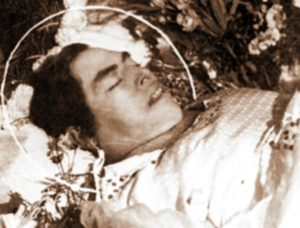 and was surely on his or her way to recovery. Fidencio once made a paralyzed girl walk by throwing candy at her to encourage her to get up to gather it (and it worked). It is unknown what his actual success rate was, but the number of people who claimed to have been healed by the Niño Fidencio run into the tens of thousands. He continued to see hundreds of people per week up until his death on October 19th 1938 at the age of 40. It is said that he died of exhaustion and that his charge on earth to heal all the people he could was too much for him in the end.
and was surely on his or her way to recovery. Fidencio once made a paralyzed girl walk by throwing candy at her to encourage her to get up to gather it (and it worked). It is unknown what his actual success rate was, but the number of people who claimed to have been healed by the Niño Fidencio run into the tens of thousands. He continued to see hundreds of people per week up until his death on October 19th 1938 at the age of 40. It is said that he died of exhaustion and that his charge on earth to heal all the people he could was too much for him in the end.
The legacy of El Niño Fidencio lives on. On his deathbed he predicted that his spirit would live on in other mediums once his physical body passed away. Immediately after his death, people began to channel the spirit of the Niño Fidencio and claimed to heal by using his energies. The most famous among them was a woman named Cipriana Zapata, more commonly known as Panita, who founded the Independent Fidencista Movement which has spread throughout Mexico and to parts of the United States. These Fidencio-inspired mediums are called materias and there are several of them who operate in the town of Espinazo to this day, sometimes concurrently, which may seem baffling, as it is a mystery how the spirit of the Niño can occupy several mediums at once. On and around every October 19th, on the anniversary of Fidencio’s death, the town of Espinazo has a fiesta which can draw up to 40,000 people. As there are very little accommodations in such a small town, many faithful people just camp out, and the outskirts of the town are reminiscent of the famous shantytown of the sick and hopeful that existed in the 1920s 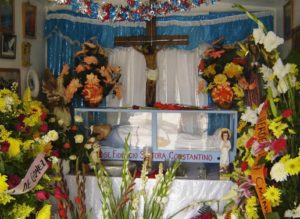 and 1930s. There are many focal points during the annual fiesta. There is the shrine devoted to Fidencio that contains his tomb and personal effects. Dedicated pilgrims crawl on their knees or get down on the floor and roll up to the main altar of the shrine. People often faint in the shrine’s presence and slip into trances. It is believed that during the fainting spell the consciousness leaves the body so that the person can be taken over by the spirit of the Niño Fidencio. Outside the shrine is what is called the charquito, a pond of sulphurous mud imbued with special healing properties. Those looking for relief from an affliction or malady are dunked three times in the black pond. Another place in the town of special reverence is the remains of the famous pepper tree found in the prophesy of the desert hermit and used by Fidencio as a place from which to conduct mass healings and blessings. The tree died many years ago from of a frost, but the trunk and some of the branches remain, cordoned off by a fence. Another main focal point of the modern-day Fidencio pilgrimage is the Cerro de la Campana, a bell-shaped hill outside of town studded with white crosses and small shrines. Here, mediums channel the Niño Fidencio and other spirits and offer healings, blessings and advice. While the fiesta lasts for days, on the exact date of Fidencio’s death, no mediums are allowed to channel Fidencio’s spirit, as it is understood that on that day Fidencio’s spirit is everywhere.
and 1930s. There are many focal points during the annual fiesta. There is the shrine devoted to Fidencio that contains his tomb and personal effects. Dedicated pilgrims crawl on their knees or get down on the floor and roll up to the main altar of the shrine. People often faint in the shrine’s presence and slip into trances. It is believed that during the fainting spell the consciousness leaves the body so that the person can be taken over by the spirit of the Niño Fidencio. Outside the shrine is what is called the charquito, a pond of sulphurous mud imbued with special healing properties. Those looking for relief from an affliction or malady are dunked three times in the black pond. Another place in the town of special reverence is the remains of the famous pepper tree found in the prophesy of the desert hermit and used by Fidencio as a place from which to conduct mass healings and blessings. The tree died many years ago from of a frost, but the trunk and some of the branches remain, cordoned off by a fence. Another main focal point of the modern-day Fidencio pilgrimage is the Cerro de la Campana, a bell-shaped hill outside of town studded with white crosses and small shrines. Here, mediums channel the Niño Fidencio and other spirits and offer healings, blessings and advice. While the fiesta lasts for days, on the exact date of Fidencio’s death, no mediums are allowed to channel Fidencio’s spirit, as it is understood that on that day Fidencio’s spirit is everywhere.
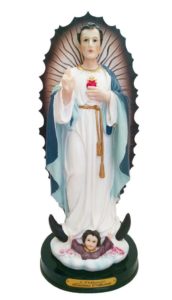 The Niño Fidencio story has lived on for many decades after the death of this mysterious folk saint, but some people remained unconvinced of this man’s power to do anything. Debunkers and disbelievers claim that Fidencio’s success rate was really not that large and that many people left Espinazo disappointed and uncured. The death rate in the shantytown was high and the town had to open up two new cemeteries to accommodate the deceased. Some point to a very political motivation for the popularity of this supposedly miraculous healer. Plutarco Calles, the president with the alleged skin condition who visited the Niño Fidencio was a declared atheist who enacted laws to break the power of the Catholic Church. Calles’ anticlerical laws were responsible for the Cristero War, a bloody conflict from 1926 to 1929 that claimed over 100,000 lives and pitted government forces against pro-Catholic Church fighters. Was President Calles’ visit to the Niño Fidencio, and the massive attention Fidencio received from the press at the time, part of a plan to create an independent spiritual movement to further dilute the power of the Catholic Church in Mexico? Was Calles really in need of a legitimate healing? We may never know. We do know that what happened in that dusty town in the early part of the 20th Century still reverberates to this day and has believers and non-believers completely mystified.
The Niño Fidencio story has lived on for many decades after the death of this mysterious folk saint, but some people remained unconvinced of this man’s power to do anything. Debunkers and disbelievers claim that Fidencio’s success rate was really not that large and that many people left Espinazo disappointed and uncured. The death rate in the shantytown was high and the town had to open up two new cemeteries to accommodate the deceased. Some point to a very political motivation for the popularity of this supposedly miraculous healer. Plutarco Calles, the president with the alleged skin condition who visited the Niño Fidencio was a declared atheist who enacted laws to break the power of the Catholic Church. Calles’ anticlerical laws were responsible for the Cristero War, a bloody conflict from 1926 to 1929 that claimed over 100,000 lives and pitted government forces against pro-Catholic Church fighters. Was President Calles’ visit to the Niño Fidencio, and the massive attention Fidencio received from the press at the time, part of a plan to create an independent spiritual movement to further dilute the power of the Catholic Church in Mexico? Was Calles really in need of a legitimate healing? We may never know. We do know that what happened in that dusty town in the early part of the 20th Century still reverberates to this day and has believers and non-believers completely mystified.
REFERENCES
El Niño Fidencio and the Fidencistas: Folk Religion in the US-Mexican Borderland by Antonio Noé Zavaleta

8 thoughts on “El Niño Fidencio: Miraculous Healer or Fake?”
This is so right on! While becoming an anthropologist, I studied Mexican-American folk healing and dispatched a paper on the subject. As a master herbalist, who uses plant based compounds and spirituality I really relate and appreciate this new information. I believe artist Frieda K Kahlo did a painting of El Nino Fidencio. This article pulled together a better understanding of issues I’ve been skirting for two decades. The idea of not channeling El Ninos healing energy on his death date because he is ‘here, there and everywhere’ corollates with my spiritual understanding of myself and my oneness with ALL. Excellent! Excellent! We are truly evolving higher!
Thank you for your comments!
The only one who cures is Jesus Christ.. He is the healer of all healers. This so called saint will never mount to God. Stop worshipping idols.
Hi
I disagree with you. Yes let’s stop worshipping idols but we are not worshipping idols. I have had healing and help from nino Fidencio.or the cajita (little box). He never claimed he was the healer but gives all credit and honor to Jesus Christ my Redeemer. No body can heal but Jesus. There is also another spiritual healer Hermana Inez de ls Cruz. She also helped me but only through the power of Jesus Christ. Stop being so perfect in religion and believe in Jesus Christ who in the Bible says he gives gifts by the Holy Spirit some to some to minister some to prophecy some to heal.etc. So we are not worshipping the nino Fidencio or any healer but pray and thank Jesus Christ the King and true healer.
he works with GOD, SO YOU STIPO INSULTING HIM!
I disagree with you. We don\’t worship idols. I have had help from nino Fidencio or cajita little box that channels his spirit. He never claimed to be the healer but gives all honor and credit to Jesus Christ. As it\’s mentioned in the Bible he gives gifts through the Holy Spirit to some of prophecy, some to translate some to minister some to heal etc. Believe in Jesus Christ and that he has the power to heal through whom he has chosen like nino Fidencio and some true faithful preachers.
Jesus Christ is the only true healer.
I married into the Lopez de la Fuente family, to one of Don Enrique’s grand daughters. I loved my mother in law as my own mother. She lived in the family hacienda with Fidencio and the rest of Don Enrique’s young family. She was four when he died., Unlike her sister Fabiola who founded the Fidencista Church in response to that of Ciprana and Manuel Robles, mi suegra stayed in the background, caring for Don Enrique in his declining years with the help of my young future wife. She was also in charge of the hacienda and Fidencio’s grave inside. Each of Don Enrique’s children (all girls) had/have their own quarters in the compound., mi suegra was often criticized for not taking part in the church but that was her decision. She passed that down to her children, who are well known to the millions of Fidencistas across Mexico and Texas..We keep a low profile although we are easy to find and various cajas and Fidencistas have reached out to us over the years. There is a lot of disinformation about Fidencio and Fidencio out there. Tony Zavaleta probably is the best informed of people outside the family, because he spent a lot of time talking with mi suegra passed in 1991.
Thanks for your comments!